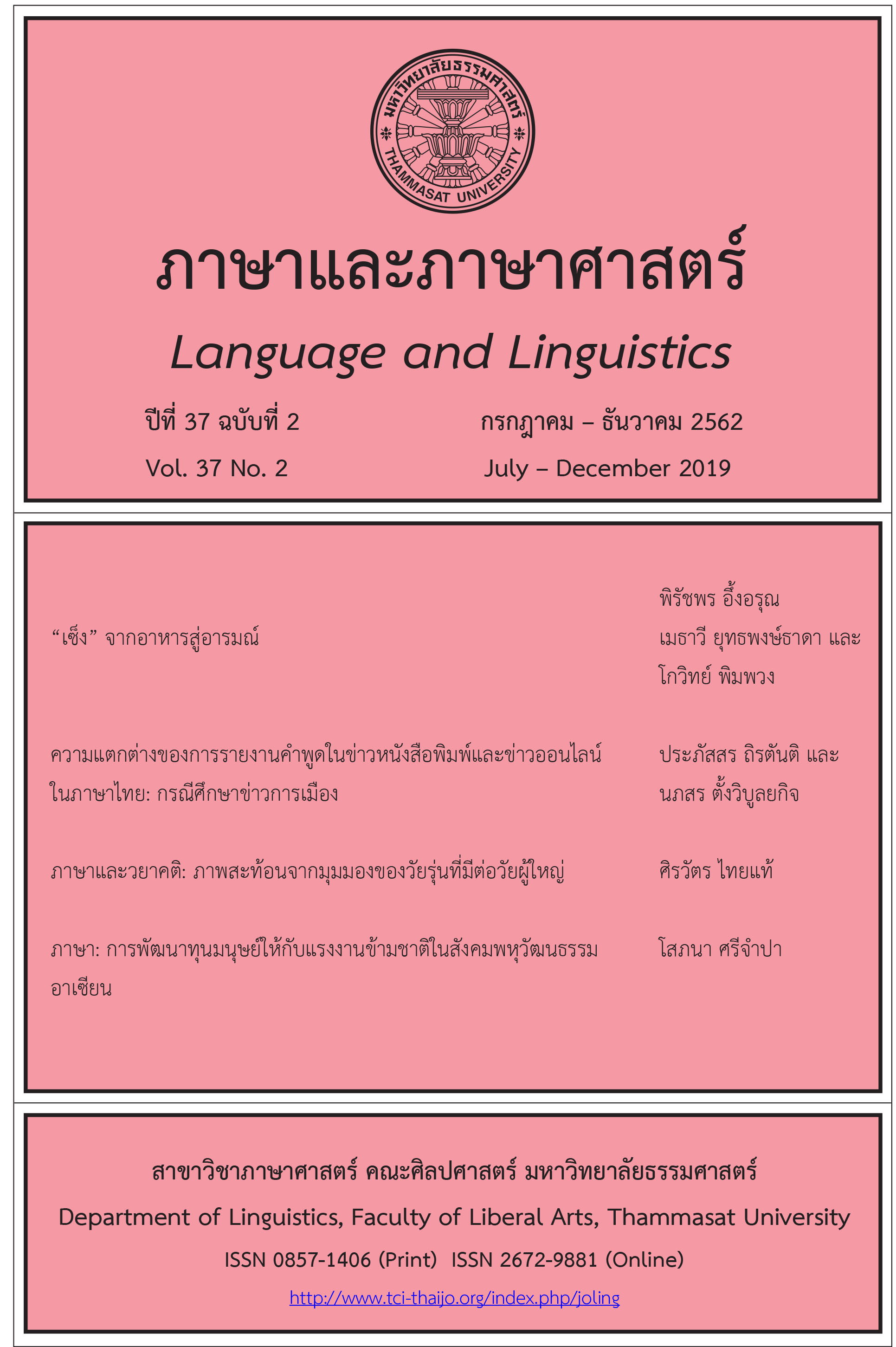Language and Ageism: Reflection from the Perspective of Adolescence towards Adulthood Language and Ageism: Reflection from the Perspective of Adolescence towards Adulthood
Main Article Content
Abstract
Ageism or a negative attitude toward others due to the different ages of interactants, is always possible when people of different ages interact with each other. Such attitudes can be reflected through the use of common language in everyday life. This article examined the linguistic characteristics of adolescents interacting with adults, aiming to see whether the pattern or linguistic features of the language shows negative views towards each other and the underlying reasoning behind that. The data were derived from a 42-episode television drama series. The study found that adolescents had a psychological perspective towards an adult, which was divided into five categories. 1) Personality and character. (Limitation of freedom, Having scolding or nagging behavior, Interfering with privacy, Having an idea or behavior that is out of date, Highlighting teenagers’ inferiority as a matter of conversation, Making a small deal into a big deal, Worrying about something that has not happened, Concealing certain truths), 2) Family responsibility. (Deficiency or neglect of duty), 3) Moral and ethical (Strict custom/traditions, Doing something that conflicts with their teachings, 4) Beliefs. (Irrational belief), and 5) Ability (Inability to act or speak, Not understanding adolescent life).
Article Details
บทความทุกบทความเป็นลิขสิทธิ์ของภาษาและภาษาศาสตร์
References
เด็กและวัยรุ่น. สืบค้นเมื่อ 29 สิงหาคม 2562 จาก
https://med.mahidol.ac.th/ramamental/psychiatristknowledge/childpsychiatrist/08062014-0831
นววรรณ พันธุ์เมธา. (2553). ไวยากรณ์ไทย (พิมพ์ครั้งที่ 3). กรุงเทพฯ: โรงพิมพ์แห่ง
จุฬาลงกรณ์มหาวิทยาลัย.
ภิญโญ ช่างสาน. (2539). เอกสารประกอบการสอนวิชาวาทการ. สงขลา: สถาบันราชภัฏสงขลา.
วิจิตรา เชิงจอหอ. (2556). วัยรุ่นไทยกับวัฒนธรรม. สืบค้นเมื่อ 29 สิงหาคม 2562 จาก
https://www.dek- d.com/board/view/3052007/
ศิรวัตร ไทยแท้. (2562). การตัดสินความสุภาพจากถ้อยคำการตอบกลับการตำหนิใน
ภาษาไทย: มุมมองจากคนสองวัย. วารสารอักษรศาสตร์, 48(1), 77-96.
ศรีประภา ชัยสินธพ. (2557). สภาพจิตใจของวัยรุ่น. สืบค้นเมื่อ 15 สิงหาคม 2562
จาก https://med.mahidol.ac.th/ramamental/generaldoctor/
06062014-0847
Beaumont, S. L., & Wagner, S. L. (2004). Adolescent-parent verbal conflict:
The roles of conversational styles and disgust emotions. Journal
of language and social psychology, 23(3), 338-368.
Macnicol, J. (2010). Ageism and age discrimination. London, England:
International Longevity Center-UK.
Shah, R., Chauhan, N., Gupta, A. K., & Sen, M. S. (2016). Adolescent-parent
conflict in the age of social media: Case reports from India. Asian
journal of psychiatry, 23, 24-26.
Spencer-Oatey, H. (2002). Managing rapport in talk: Using rapport sensitive
incidents to explore the motivational concerns underlying the
management of relations. Journal of Pragmatics, 34(5), 529-545.
_______. (2005). (Im) politeness, face and perceptions of rapport:
Unpackaging their bases and interrelationships. Journal of Politeness Research. Language, Behaviour, Culture, 1(1), 95–119.
_______(Ed.). (2008). Culturally speaking: Culture, communication and politeness theory (2nd ed.). New York, NY: Continuum.


